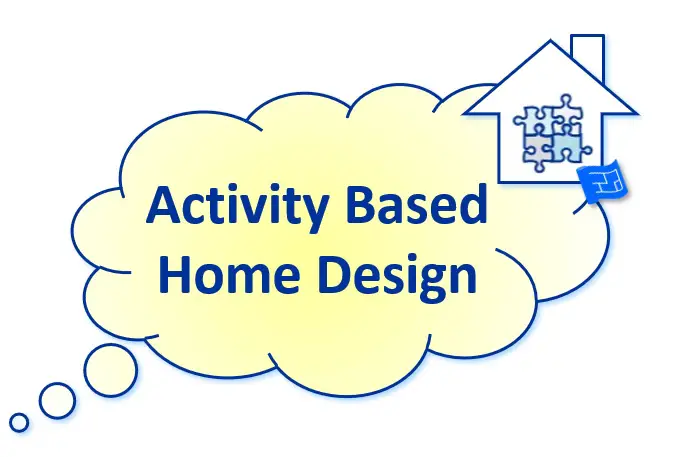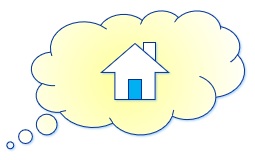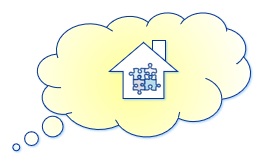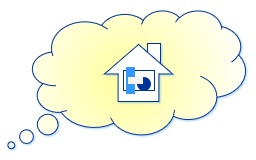- Home
- Create Your Design Brief
- Activity Based Home Design
Activity Based Home Design
Activity Patterns
Activity based home design is all about activity patterns. Let me start by explaining what activity patterns are all about. Let’s use the living room as an example. Everyone would include some sort of living space on their list of rooms that they’d like in their ideal home. And as long as there is a living room or a sitting room or a great room or family room on the plan then it's job done, right?
Not so fast. I think we can design a better space using activity based home design, more specifically using activity patterns.
Activity based home design is part of the design brief process.
Let's see how using activity patterns can be the difference between your living space being a bland rectangle with a TV and a sofa, and your living space being a haven of relaxation for your and your family.
Naturally activity based home design can be applied to any activity you carry out in your home.
How does activity based home design work?
To examine your activity patterns you’ll embark on some exercises with two main purposes:
- Firstly, doing the activity patterns exercises ensures that your home will function well by accommodating the activities and the related people, light, storage and equipment etc required. Activity patterns help you understand the functional requirements of your home in greater depth.

I believe that the way people live can be directed a little by architecture.
Tadao Ando
- Secondly activity patterns identify ways in which the experience of the activity can be improved, or can be tweaked to improve the relationships between family members.

The job of buildings is to improve human relations: architecture must ease them, not make them worse.
Ralph Erskine
Make things easy for yourself (your home needs to be functional)
If a home doesn’t function well, this takes a toll in the form of a small mental load. For example, ‘that door is really annoying – it opens right into that cupboard so I have to do an open the door, close the door dance every time I need to get into the cupboard’ or ‘there’s nowhere to sit and read quietly when the kids are watching TV’. Just little bits of annoyance that you can do without.
An activity based home design process based on the activities that make up your day to day life rather than thinking just in terms of spaces leads to a more livable, elegant and efficient home design.
With a bit of forethought about your home design you can add elements that will increase the pleasure in your daily comings and goings around your home. For example, if you’re planning a skylight in a bathroom, why not add a skylight in just the right place above the bath so that you can enjoy watching the leaves blow on a tree while you’re taking a bath. It doesn’t cost any more to put that skylight in the right place (rather than in a place that doesn't offer a sky view) but you’ve made taking a bath more joyful.
Find out your about your activity patterns
The good news is that you can use the House Plans Helper Design Brief Work Book (available here - coming soon) to guide you to a home that functions just the way it needs to for your household.
The House Plans Helper Activity Patterns Workbook will guide you through your home based activities and help you to:
- Gain a detailed understanding of how you want to live in your home.
- Seize design opportunities to elevate the experience of your home.
- Work out how your home design could improve your relationships.
- Give an insightful design brief to your architect or design professional.

It is the pervading law of all things organic and inorganic,
Of all things physical and metaphysical,
Of all things human and all things super-human,
Of all true manifestations of the head,
Of the heart, of the soul,
That the life is recognizable in its expression,
That form ever follows function. This is the law.
Louis Sullivan
Activity based home design in action
Let's look at an example of activity based home design in action.

Sarah's living room
Sarah took part in an activity patterns exercise to help design her living room.
This is a summary of the list of activities that go on in Sarah’s living room:
- Watching TV as a family
- Reading
- Relaxing by the fire
- Hosting book club
- Knitting
- Tidying the kids' toys up
When looked at in more detail, here’s what Sarah’s wish list for the living room turned out to be…
- The main thing that goes on in our living room is watching TV, so it should be set up for watching TV to be really comfortable for our family of five. If possible, I’d like to be able to hide the TV when we’re not using it.
- I want a bay window that will hold two chairs to create an area for talking and a quiet area for reading with good natural light or looking at the view. There needs to be a power socket in the bay window for a lamp for reading when it’s dark.
- I’d love to have a fireplace in the living room.
- I need to seat 8 for book club. If there’s seating for the five of us, then we can turn the two chairs in the window round. If there was room for a bench that could be used for some additional seating that would be ideal, rather than bringing in chairs from another room.
- I enjoy knitting in front of the TV. Usually I can knit on autopilot but occasionally I need more light so there needs to be a power socket for a lamp. I’d also like to be able to store my knitting in the living room, so I guess I should look at buying side tables or a coffee table that can accommodate this.
- I want the living room to be a tidy space. The kids are going to be allowed in there with their stuff, and I want to be able to get them to tidy up quickly rather than it being me that tidies up. Then I hope I’ll have to nag them less. Maybe some big boxes that can be stashed away out of sight quickly.
This detailed list of needs based on the living room activities, along with input from other members of the family, was used to design the living room especially for Sarah and her family.
She also picked out the following activities for extra enjoyment and relationship improvement.
- Creating a special space for those ‘let’s talk’ occasions.
- Creating a space to sit quietly and enjoy the view.
- Planning where to display a sculpture that we bought for our wedding anniversary.
So I think we can all agree that that list throws up far more requirements for the living space. The floor plan will need to include the following rather than just be a plain space.
- The TV location
- The fireplace location
- Bay window
- The proposed seating for TV, reading and book club
- Side table locations
- A power point for the lamp for reading
- Perhaps built in cupboards for storage of toys.
When the plan is available you can check the plan by imagining carrying out each of the activities. Will the proposed space work for each activity?





